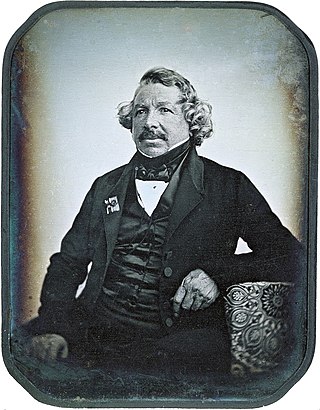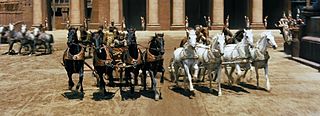
Robert Norton Noyce, nicknamed "the Mayor of Silicon Valley", was an American physicist and entrepreneur who co-founded Fairchild Semiconductor in 1957 and Intel Corporation in 1968. He was also credited with the realization of the first monolithic integrated circuit or microchip made with silicon, which fueled the personal computer revolution and gave Silicon Valley its name.

Widescreen images are displayed within a set of aspect ratios used in film, television and computer screens. In film, a widescreen film is any film image with a width-to-height aspect ratio greater than 4:3 (1.33:1).

35 mm film is a film gauge used in filmmaking, and the film standard. In motion pictures that record on film, 35 mm is the most commonly used gauge. The name of the gauge is not a direct measurement, and refers to the nominal width of the 35 mm format photographic film, which consists of strips 1.377 ± 0.001 inches (34.976 ± 0.025 mm) wide. The standard image exposure length on 35 mm for movies is four perforations per frame along both edges, which results in 16 frames per foot of film.

70 mm film is a wide high-resolution film gauge for motion picture photography, with a negative area nearly 3.5 times as large as the standard 35 mm motion picture film format. As used in cameras, the film is 65 mm (2.6 in) wide. For projection, the original 65 mm film is printed on 70 mm (2.8 in) film. The additional 5 mm contains the four magnetic stripes, holding six tracks of stereophonic sound. Although later 70 mm prints use digital sound encoding, the vast majority of existing and surviving 70 mm prints pre-date this technology.

Daguerreotype was the first publicly available photographic process, widely used during the 1840s and 1850s. "Daguerreotype" also refers to an image created through this process.
A movie camera is a type of photographic camera that rapidly takes a sequence of photographs, either onto film stock or an image sensor, in order to produce a moving image to display on a screen. In contrast to the still camera, which captures a single image at a time, the movie camera takes a series of images by way of an intermittent mechanism or by electronic means; each image is a frame of film or video. The frames are projected through a movie projector or a video projector at a specific frame rate to show the moving picture. When projected at a high enough frame rate, the persistence of vision allows the eyes and brain of the viewer to merge the separate frames into a continuous moving picture.

Henri Jacques Chrétien was a French astronomer and an inventor.

CinemaScope is an anamorphic lens series used, from 1953 to 1967, and less often later, for shooting widescreen films that, crucially, could be screened in theatres using existing equipment, albeit with a lens adapter.

Louis Aimé Augustin Le Prince was a French artist and the inventor of an early motion-picture camera, and director of Roundhay Garden Scene.

The Frazier lens is a special camera lens designed by Australian photographer Jim Frazier. The Frazier lens provides an appearance of a massive depth of field, allowing the foreground and background of an image to be in focus. Frazier's lenses have been widely used in Hollywood and wildlife cinematography. In addition to its unique depth of field properties, the Frazier lens is significantly smaller than previous deep focus lenses allowing more versatility and flexibility to cinematographers. The main feature of the lens, an extended tube with a rotating prism, allows cinematographers to place the camera in a variety of positions for a given shot. Cinematographers then rotate the prism to correct the horizon. This feature allows directors and camera operators to achieve shots in minutes that previously took cinematographers hours in rigging and designing special sets to accommodate shooting positions.

Panavision is an American motion picture equipment company founded in 1954 specializing in cameras and lenses, based in Woodland Hills, California. Formed by Robert Gottschalk as a small partnership to create anamorphic projection lenses during the widescreen boom in the 1950s, Panavision expanded its product lines to meet the demands of modern filmmakers. The company introduced its first products in 1954. Originally a provider of CinemaScope accessories, the company's line of anamorphic widescreen lenses soon became the industry leader. In 1972, Panavision helped revolutionize filmmaking with the lightweight Panaflex 35 mm movie camera. The company has introduced other cameras such as the Millennium XL (1999) and the digital video Genesis (2004).
Super Panavision 70 is the marketing brand name used to identify movies photographed with Panavision 70 mm spherical optics between 1959 and 1983. It has since been replaced by Panavision System 65.

Ultra Panavision 70 and MGM Camera 65 were, from 1957 to 1966, the marketing brands that identified motion pictures photographed with Panavision's anamorphic movie camera lenses on 65 mm film. Ultra Panavision 70 and MGM Camera 65 were shot at 24 frames per second (fps) using anamorphic camera lenses. Ultra Panavision 70 and MGM Camera 65's anamorphic lenses compressed the image 1.25 times, yielding an extremely wide aspect ratio of 2.76:1.

A timeline of United States inventions encompasses the ingenuity and innovative advancements of the United States within a historical context, dating from the Contemporary era to the present day, which have been achieved by inventors who are either native-born or naturalized citizens of the United States. Patent protection secures a person's right to his or her first-to-invent claim of the original invention in question, highlighted in Article I, Section 8, Clause 8 of the United States Constitution which gives the following enumerated power to the United States Congress:
To promote the Progress of Science and useful Arts, by securing for limited Times to Authors and Inventors the exclusive Right to their respective Writings and Discoveries.
Gottschalk v. Benson, 409 U.S. 63 (1972), was a United States Supreme Court case in which the Court ruled that a process claim directed to a numerical algorithm, as such, was not patentable because "the patent would wholly pre-empt the mathematical formula and in practical effect would be a patent on the algorithm itself." That would be tantamount to allowing a patent on an abstract idea, contrary to precedent dating back to the middle of the 19th century. The ruling stated "Direct attempts to patent programs have been rejected [and] indirect attempts to obtain patents and avoid the rejection ... have confused the issue further and should not be permitted." The case was argued on October 16, 1972, and was decided November 20, 1972.

Anamorphic format is the cinematography technique of shooting a widescreen picture on standard 35 mm film or other visual recording media with a non-widescreen native aspect ratio. It also refers to the projection format in which a distorted image is "stretched" by an anamorphic projection lens to recreate the original aspect ratio on the viewing screen. The word anamorphic and its derivatives stem from the Greek anamorphoo, compound of morphé with the prefix aná.
Richard Moore was an American cinematographer. In 1953, Moore teamed with Robert Gottschalk to co-found Panavision.

The Arri Alexa is a digital motion picture camera system developed by Arri. The Arri Alexa was introduced in April 2010 and was Arri's first major transition into digital cinematography, after previous efforts including the Arriflex D-20 and D-21.
Takuo Miyagishima was a Japanese-American design engineer who worked for Panavision. He was responsible for many of the company's innovations in motion picture photography and projection, and also designed the company's logo.














